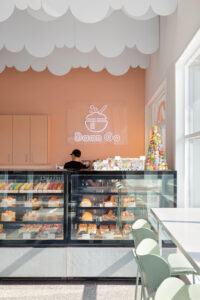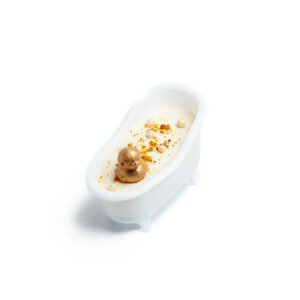Categories Pastry Chef Articles
“Daan Go Cake Lab is a Laboratory allows me to develop recipes in a scientific manner”
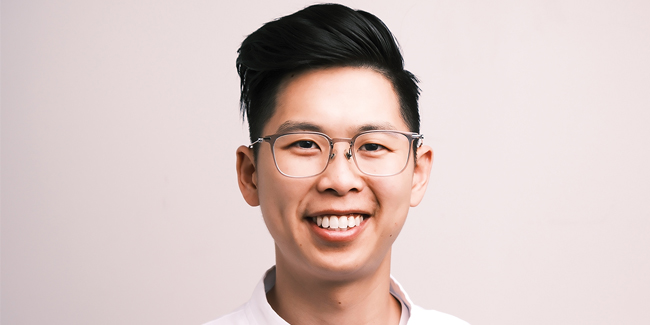
Having studied Biology, Chemistry, and Pharmacy, Christopher Siu develops recipes in a scientific way and enjoys finding ways to achieve the texture and flavor he wants when constrained by limitations in sweetness or fat percentage.
At Daan Go Cake Lab in Toronto, the chef, of Chinese origin, combines the best of Western and Eastern pastries. Here he offers something unique and different while promoting an appreciation for Asian culture. His visionary creations have earned acclaim within the pages of illustrious wedding and lifestyle publications, as well as renowned food and travel blogs.
Regarding future trends, Siu is clear that AI is going to become a source of new flavors, designs, recipes, and, eventually, labor.
Why did you decide to dedicate yourself professionally to pastry?
I was inspired by the memories of my childhood. Growing up, my Dad would make cheesecake for my birthdays. Despite not being a chef, he put forth his best effort to create something special for us on our birthdays, and I recall it being the most delicious cheesecake I had ever tasted. This experience introduced me to the joy of dedicating time and effort to craft something unique and special for the people you love. Additionally, as a child I was also fascinated by foods with distinctive colors or shapes. I distinctly remember enjoying items that were green or oddly-shaped Halloween candy. This sparked my fascination with the diverse possibilities of sweets. Consequently, I developed a deep love for pastry as a medium to express myself and create delightful treats that brought me immense joy.
“Despite a childhood interest in pursuing hospitality and food as a profession, it was discouraged in my upbringing and community. The prevailing sentiment was that the hospitality industry lacked profitability and a promising future”
How did you carry out your self-study in pastry?
I never received formal professional training in pastry. For me, pastry became a scientific endeavor, seamlessly aligning with my studies in Biology, Chemistry, and eventually Pharmacy. Understanding how variations in chemical structure impact stability, texture, and flavor became a crucial aspect. This knowledge significantly enhanced my ability to develop recipes and flavors that could maintain quality while being scalable.
Despite a childhood interest in pursuing hospitality and food as a profession, it was discouraged in my upbringing and community. The prevailing sentiment was that the hospitality industry lacked profitability and a promising future. Instead, I devoted my spare time to refining my skills through self-learning via books and online courses. Fortunately, my relatives and parents recognized my passion for baking and supported me with related gifts. One of my initial gifts was “Baking Illustrated,” containing 350 meticulously curated recipes, each with its introduction and an explanation of the recipe’s creation. The book employed a scientific approach to baking, presenting tested variations and their conclusions. Subsequently, I augmented my learning by purchasing textbooks from colleges offering pastry programs, combining formal education with personal palate development.
Reflecting on this journey, I believe this approach was not only suitable for me but also liberated me from traditional techniques and concepts. It provided the freedom I required for a high level of autonomy in my learning.
In 2017 you opened Daan Go Cake Lab. What was its purpose? How would you define it?
Daan Go Cake Lab was established simply because I saw a strong difference between the style of pastry making in the eastern and western world. Difference in technique, product, and texture. As a Canadian-born Chinese, I found I had a specific palate for both eastern and western desserts and so I sought to create a bakery that could encapsulate my favorites from both sides.
I define Daan Go Cake Lab as a Laboratory simply because it is a place where it allows me to develop recipes in a scientific manner. I start with ratios of macronutrients based on a flavor profile and the final product I want to establish. And from there I modify ingredients and techniques to reach the final product. For example if I want texture in a mousse, I may consider the use of various modified starches versus dietary fibers, or if I require a gel that is fluid under pressure but will hold its shape under other circumstances then I look to complex starches such as pectin versus gelling or thickening agents. I enjoy the challenge of finding ways to achieve the texture and flavor I want when constrained by limitations in sweetness or fat percentage.
“I enjoy the challenge of finding ways to achieve the texture and flavor I want when constrained by limitations in sweetness or fat percentage”
Although it is an establishment based in Canada, you offer a menu of products that speaks of your Asian origin: Durian fruit, Roasted Pig, and the innovative Hot Pot Cake. Is this what makes your desserts special or different?
The reason I choose to incorporate many desserts with connections to Asian origins is something that evolved as Daan Go grew. As a child I often struggled to connect my Asian heritage and the Western culture around me. Creating this line of pastries became a means to normalize and bring to light many aspects of my upbringing to a larger audience, with the hope of building a platform for others to move forward. In a way, I also see myself as an artist challenging individuals to reconsider what cake can be and how it can serve as a platform for self-expression.
This kind of pastry reconnects me with memories from my childhood—the feeling of receiving something exceptionally special and the curiosity and surprise it brings. I aim for people to have a similar experience, encountering something unique and different from what is commonly found in the market, while also introducing and promoting these Asian concepts within the community.
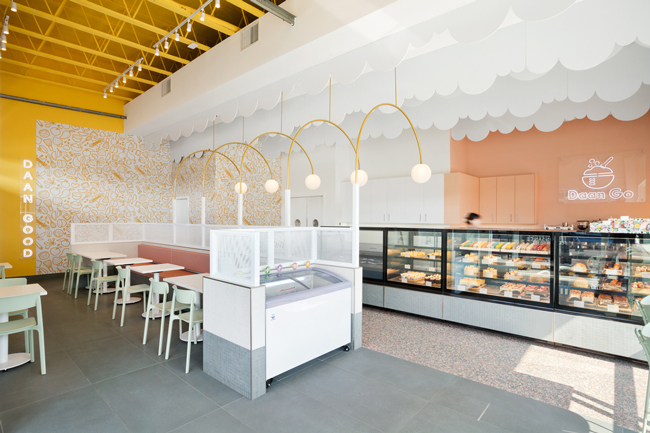
What is your favorite dessert and why?
Surprisingly, my favorite dessert is not cake but the humble Chinese Almond Cookie. Despite not containing almond flour, only almond extract and a whole almond on top, it aligns with my fascination for variations in technique leading to diverse textures and flavors. The use of lard imparts a specific savory note, and its low moisture content contributes to a crumbly texture. The egg wash, uncommon in traditional shortbread-style recipes, gives it a distinct appearance and a curious yolk flavor. Together, these elements create a unique flavor profile of egg yolk, almonds, and lard that I haven’t found replicated elsewhere.
“As a child I often struggled to connect my Asian heritage and the Western culture around me. Creating this line of pastries became a means to normalize and bring to light many aspects of my upbringing to a larger audience”
The business already has four locations in Toronto and one location in Vancouver. What do you attribute this growth to? Are there plans to continue expanding?
Since opening in November 2017, we have expanded to approximately one store per year. I attribute our success to my wife Angela, who together with me brought life to Daan Go. Today she continues to contribute to various aspects of the company. The second factor is our passion for innovation, constantly creating pastry items to offer a new sensation or experience with each recipe and design. Looking forward, we plan to continue expanding so that we may reach an even bigger audience.
You are also the creator of a very different gastronomic concept, Pâtisserie Fleur, a modern French pastry shop. What do you offer here?
At Patisserie Fleur, we provide a more classic offering, particularly entremets with Japanese influence in many recipes. It differs significantly from Daan Go, despite both being my creations. With Fleur, I aimed to explore subtlety, considering ways to improve an ingredient’s flavor without simply adding more of it.
“I encourage my staff to understand that technique is vital for creating freely, but it’s only the beginning. The crucial step is thinking about how you want to express yourself”
In 2019, you competed in MasterChef back to win Canada and won the title. What prompted you to compete in this TV program? And what did winning mean to you?
I initially competed in MasterChef Canada in 2013 while still a student in Pharmacy school. My goal was not to win but to explore more of the culinary world, hastening my eventual goal of having my own patisserie. Although I didn’t win, I was invited back for the MasterChef: Back to Win season, ultimately claiming victory. Winning meant a lot to me, validating my journey in the culinary world.
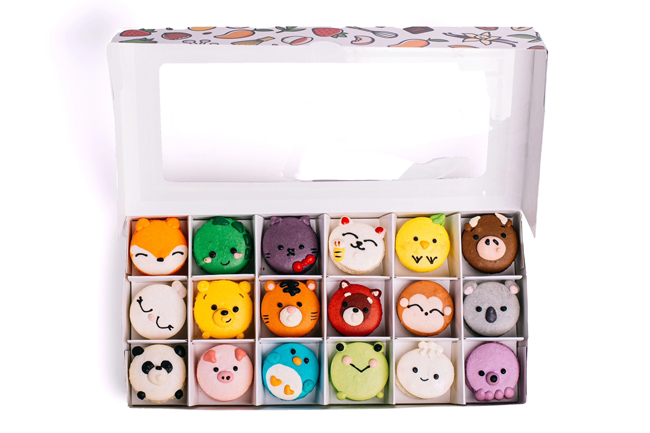
This has not been your only participation in a contest. Do you think a pastry chef needs to constantly challenge himself to improve?
Without a doubt, my journey in the pastry world has been characterized by constant challenges. Lacking professional training, I often found myself in the dark when approaching problems. However, with time and persistence, I discovered my own way through. I encourage my staff to understand that technique is vital for creating freely, but it’s only the beginning. The crucial step is thinking about how you want to express yourself. Constantly challenging ourselves with the things around us, examining what we like, dislike, and how we would change it, serves as a great starting point. This is where inspiration can be found in all things.
“As AI develops, it will become a source for new flavors, designs, recipes, and eventually, labor”
What will pastry, in your opinion, be like in the future? What are the trends for the next few years?
Pastry in the future will heavily rely on AI. As AI develops, it will become a source for new flavors, designs, recipes, and eventually, labor. However, I can foresee the next few years focusing more on reducing waste and the carbon footprint of bakeries. The trend in vegan pastry making is a precursor, and the next step would be to concentrate on sustainable and low carbon produce and manufacturing as the foundation for pastry making.
